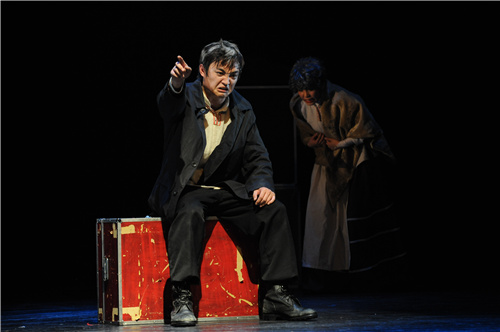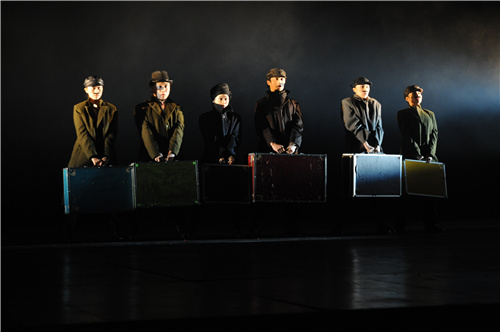
Director: Zhang Jing
Playwright: Anton Chekhov
Institution: Nanyang Academy of Fine Arts, Singapore
Venue: North Theatre
Time: 19:30, May 20, 2012
Event: The 2nd Asian Theatre Schools Festival

Director’s Notes
As a theatre educator, it is a great honour to direct Chekhov's works, because it reflects the strongest light of realism through his writing. He once said, "Whoever wants to describe human and life should often acquaint himself with life, instead of studying it from books." The theatre art is not a castle in the air. Without efforts repeated day in and day out, how can thousands of mansions come into being?
-"Conciseness is the sister of talent"
-"The art of writing is the art of refining"
Although Chekhov's late works, such as Three Sisters, The Cherry Orchard and Seagull can be dubbed as immortal works in the treasure house of theatre, his early short stories attract me more with sharp, meaningful and smooth writing styles. Most of Chekhov's works are about the sufferings and dreams of ordinary people. He is good at exploring life through observing people and things. He adds artistic processes into many plots which seem to be ridiculous but meaningful indeed. Even after a hundred years, today people can still identify the right roles in his works.
Among his numerous excellent works, I have chosen four short stories to adapt. They are In the Carriage, Kashtanka, Rothschild's Violin, and The Man in a Case. In these works, there are generally no complex plots, no dramatic changes in characters' relations, no sharp oppositions in contradiction and no breathless suspense. Basically all the stories are told in a calm and objective tone and all the figures' internal monologues are described in details. But these works offer us more room to imagine our creation and explore more inner world of the characters. For this reason, I used much body language to strengthen the visual impact and maximize the restoration of delicacy and profound realistic significance of Chekhov's works, so that the artistic effect can be achieved. In the process of creation, the adaptation of novels is my biggest challenge.
The curtain rises. A trace of darkness blinds our sight. With a roar, a "Train of Life" rushes onto the stage from the "Happiness Station". Pushing and shoving, the crowds risk their lives squeezing into the uncertain journey of life and catch the train leading to death. Those “suitcases" in their hands witness their pride, confusion, sorrow and sigh. Whether life is long or short, when they look back on the past, the only thing they have owned for the whole life is the "suitcase" in the hand. They used to push pull, carry, hold, step on and lie on such suitcases. But at last, their "masters" would eventually be buried in silence. The “suitcases” would then turn into coffins, recording variegated years of every master and giving a full stop to their happy or painful lives.

Synopsis
In the Carriage tells a story where a train whirled from the "Happiness Station" to the "Grave Station" at full throttle. "Bad things will happen. Bad things will happen! “Such a scream came out of the old and trembling carriage ... In the carriage, it was dark everywhere. Pickpockets came and went by in a continuous way together with drafts. By the faint light in the dark, people were busy with their own stuff: eating, sleeping, playing solitaire, gambling, billing and cooing as well as telling stories. Then there came the story of Kashtanka. In the story, the joiner Luca Alexandria Dredge, with his son and his dog Kashtanka, went out to work. In their way back home, the master went to a pub, got drunk there and fell down in the street. In the parade full of drum sound, Kashtanka ran away and hided himself hurriedly. Finally, he lost himself. He looked around to seek for his master, but failed. Helplessly, he ran and wandered i the street. At last, with a whine, he tiredly huddled himself up at the gate of a family. All of a sudden, a middle-aged man in a top-hat, with a suitcase in his hand, stepped on him and took him home. Then, a series of unexpected things took place... In Rothschild's Violin, Tretyakov was a very famous coffin maker and also a wedding musician. Although he was good at playing violin, he was penniless. He was always bothered by some inexplicable “loss “. At first, he thought his wife was worthless, but until she passed away after so many sufferings, he started his deep guiltiness for his behaviour to her. When he thought of the fact that after his death, his beloved violin would be orphaned, he could not help composing elegies out of sadness for his violin. In The Man in a Case, Belikov was a secondary school teacher, but he was a typical character who cleaved to old systems and always looked backward. He was unsociable and eccentric, timid and overcautious. Even in sunny days, he would take an umbrella with him, put on galoshes and indent his head into overcoat collar. He tried his best to wrap himself with a case. He refused to contact with the outside world and never accepted new things. Eventually, when he laid in his coffin miserably, he was considered to find his ideal destination.

